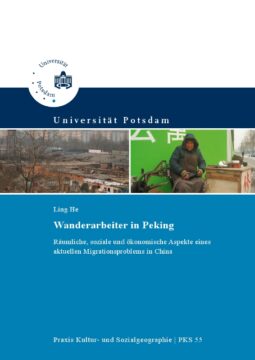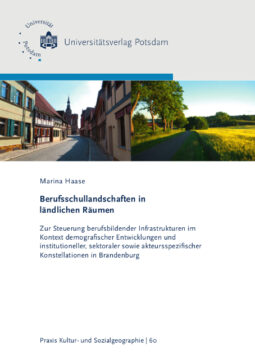Bilingual teaching is considered to be the most successful model for foreign language acquisition in German classrooms. Being proficient in at least one foreign language, both orally and in writing, is an essential capability for vocational education in a world shaped by globalization. Foreign language acquisition especially profits from merging subject-specific learning and language skills in bilingual learning settings. At the same time, the discrepancy between foreign language skills and subject-specific capabilities of the learners in bilingual subject teaching is a great challenge for subject-specific learning. Educators face the challenge of designing bilingual learning settings that allow students to deal with complex geographical problems while at the same time ensure that students do not feel overwhelmed in regard to their foreign language abilities.
Using a Design-Based-Research approach, this study investigated how subject-specific learning can be promoted by using both languages involved (English/German) in a bilingual geography classroom setting.
Based on current research findings in bilingual teaching and conceptual learning in geography education, we designed a learning environment that implements strategies of language switching to promote subject-specific learning. After implementing this setting in a geography classroom, we re-designed the learning environment according to our findings for a second implementation phase.
The study provides relevant findings in terms of veritable bilingual teaching and learning in geography lessons. Moreover, insights are given into conceptual learning by using the geographical concept of change. A set of 6 lessons on the topic of changes at different places have been developed for a geography classroom, including a didactical concept and teaching materials.
Eine Design-Based-Research-Studie im bilingualen Geographieunterricht am Beispiel des Fachkonzepts Wandel
ISBN: 978-3-86956-557-6
360 pages, Paperback
Release year 2023
Series: Potsdamer Geographische Praxis , 19
22,50 €
Non-taxable transaction according to § 1 (1) UStG/VAT Act in combination with § 2 (3) UStG/VAT Act a. F. Providing this service, the University of Potsdam does not constitute a Betrieb gewerblicher Art/Commercial Institution according to § 1 (1) No. 6 or § 4 KStG/Corporate Tax Act. If the legal characterization of our business is changed to a commercial institution subsequently, we reserve the right to invoice VAT additionally. zzgl. Versandkosten
Bilingual teaching is considered to be the most successful model for foreign language acquisition in German classrooms. Being proficient in at least one foreign language, both orally and in writing, is an essential capability for vocational education in a world shaped by globalization. Foreign language acquisition especially profits from merging subject-specific learning and language skills in bilingual learning settings. At the same time, the discrepancy between foreign language skills and subject-specific capabilities of the learners in bilingual subject teaching is a great challenge for subject-specific learning. Educators face the challenge of designing bilingual learning settings that allow students to deal with complex geographical problems while at the same time ensure that students do not feel overwhelmed in regard to their foreign language abilities.
Using a Design-Based-Research approach, this study investigated how subject-specific learning can be promoted by using both languages involved (English/German) in a bilingual geography classroom setting.
Based on current research findings in bilingual teaching and conceptual learning in geography education, we designed a learning environment that implements strategies of language switching to promote subject-specific learning. After implementing this setting in a geography classroom, we re-designed the learning environment according to our findings for a second implementation phase.
The study provides relevant findings in terms of veritable bilingual teaching and learning in geography lessons. Moreover, insights are given into conceptual learning by using the geographical concept of change. A set of 6 lessons on the topic of changes at different places have been developed for a geography classroom, including a didactical concept and teaching materials.
Recommended Books
-
 2013
2013Wanderarbeiter in Peking
16,50 €Non-taxable transaction according to § 1 (1) UStG/VAT Act in combination with § 2 (3) UStG/VAT Act a. F. Providing this service, the University of Potsdam does not constitute a Betrieb gewerblicher Art/Commercial Institution according to § 1 (1) No. 6 or § 4 KStG/Corporate Tax Act. If the legal characterization of our business is changed to a commercial institution subsequently, we reserve the right to invoice VAT additionally.
zzgl. Versandkosten
Add to cart -
 2022
2022L’initiative «Universités Européennes»
Non-taxable transaction according to § 1 (1) UStG/VAT Act in combination with § 2 (3) UStG/VAT Act a. F. Providing this service, the University of Potsdam does not constitute a Betrieb gewerblicher Art/Commercial Institution according to § 1 (1) No. 6 or § 4 KStG/Corporate Tax Act. If the legal characterization of our business is changed to a commercial institution subsequently, we reserve the right to invoice VAT additionally.
Read more -
 2020
2020Manfred Rolfes, Wilfried Schubarth, Michael Kohlstruck, Dagmar Bode
Das Handlungskonzept „Tolerantes Brandenburg“ im Fokus
16,00 €Non-taxable transaction according to § 1 (1) UStG/VAT Act in combination with § 2 (3) UStG/VAT Act a. F. Providing this service, the University of Potsdam does not constitute a Betrieb gewerblicher Art/Commercial Institution according to § 1 (1) No. 6 or § 4 KStG/Corporate Tax Act. If the legal characterization of our business is changed to a commercial institution subsequently, we reserve the right to invoice VAT additionally.
zzgl. Versandkosten
Add to cart -
 2017
2017Berufsschullandschaften in ländlichen Räumen
31,00 €Non-taxable transaction according to § 1 (1) UStG/VAT Act in combination with § 2 (3) UStG/VAT Act a. F. Providing this service, the University of Potsdam does not constitute a Betrieb gewerblicher Art/Commercial Institution according to § 1 (1) No. 6 or § 4 KStG/Corporate Tax Act. If the legal characterization of our business is changed to a commercial institution subsequently, we reserve the right to invoice VAT additionally.
zzgl. Versandkosten
Add to cart
Publisher Info
Contact
Potsdam University Library
University Press
Am Neuen Palais 10
14476 Potsdam
Germany
verlag@uni-potsdam.de
0331 977-2094
0331 977-2292





